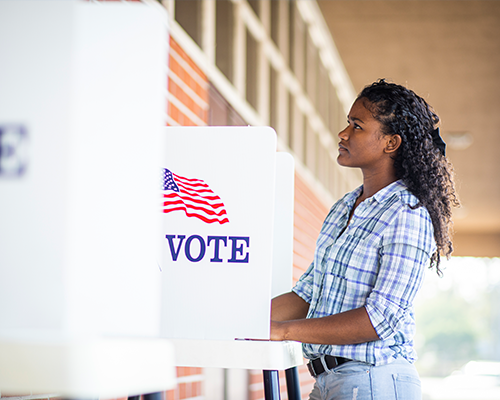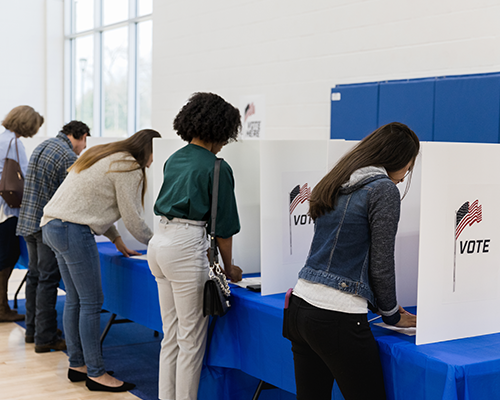
How Does Pennsylvania Ensure Final Election
results are accurate?









Mail-In and Absentee Ballots
In Pennsylvania, mail-in and absentee ballots are processed as follows:
- The unique barcode from a ballot return envelope is scanned into the statewide voter database allowing the election officials to check whether the voter properly requested the mail-in or absentee ballot.
- The return of the ballot is then logged into the system and reflected in that voter’s record.
- An election official checks that all of the required information is filled in on the external ballot return envelope.
- If all the information is present and correct, the official opens and sets aside the external ballot return envelope to ensure the ballot remains private.
- The secrecy envelope is then inspected for identifying marks. If marks are found, that ballot is set aside.
- Secrecy envelopes without any identifying markings are opened and the ballots removed.
- The ballot is then unfolded and scanned to record the vote.

Election Day ballot processing & tabulation
Pennsylvania uses certified and inspected vote tabulators to count ballots. Studies have shown that vote tabulators are more accurate, faster, and less expensive than hand counting ballots. As a security measure, they create an image of each ballot cast.
Absentee and mail-in ballots are also counted using secure vote tabulators starting on Election Day.
Vote counts and election results are available on a rolling basis here.

It is not unusual for early reported election results to change after election night, and it does not mean there has been fraud or misconduct.
There are multiple steps in the process of counting ballots to ensure the results are accurate. That process can take a while because absentee and mail-in ballots are coming into election offices, by mail or secure drop box, until 8 p.m. on Election Day. Local election workers and officials may need time to process those ballots well past midnight on Election Day, to ensure every vote is counted. And overseas ballots can arrive up to a week after Election Day. Results cannot be finalized and certified until all ballots – absentee, mail-in, overseas, and in-person – are tabulated.
If more voters for one candidate choose to vote by mail than voters for another candidate, the partial vote counts can change between election night and when the last results are tallied. This is because election officials in Pennsylvania cannot start counting mail-in and absentee ballots until Election Day and the vote totals are being updated as batches of votes are being counted
Remember that when television networks and other media outlets “call” the results of a race on election night, they are making a projection based on an incomplete count and historical data.
After all in-person and absentee ballots are counted, there are additional steps each county election board completes to ensure results are accurate. These steps are canvassing (finalizing the vote count), certification, post-election audits, and if needed, recounts.
Like any other machine, a ballot tabulator can occasionally experience problems. With advance training, election workers are prepared to handle them.
In the event of a power outage or similar issue, ballots that have been filled out by a voter but cannot be scanned are placed in a secure bag for later tabulation. The ballots will be tabulated by election workers once the technical issue is resolved. If needed, in some jurisdictions, emergency paper ballots will be provided by election workers.
Some paper ballots may require additional examination to determine if they are eligible to be included in the vote count, or to determine a voter’s intent. When that happens, the board of canvassers or county election board officials follow rules established in state law to determine whether the ballot can be counted for some, all, or none of the races for which it was submitted. Generally, two election inspectors, one from each party, work together to try to determine what the voter intended.

A bipartisan team of election inspectors will review a ballot if it is not clear who the voter intended to vote for. For example, the voter may have only partially filled in a bubble next to a candidate’s name. Or the voter may have filled in bubbles next to the names of multiple candidates in the same race. Or the voter may have written in a candidate’s name and the name is hard to read.
Checking the results
After each precinct reports its results to the county elections office, election officials count the number of ballots that have been returned from that precinct, the number of ballots that were scanned, and the number of people who checked in to vote at the precinct. They make sure all of the numbers line up. Any differences are promptly investigated and reconciled.
Throughout this process, multiple officials from the county and state level scrutinize the data for any inconsistencies and immediately investigate them. The final county results are scrutinized by the bipartisan county election board at a public meeting and the results are certified once the board verifies they are accurate.
Because Pennsylvania law requires paper ballots, there is always a paper record that can be reviewed. Election officials are also required by law to conduct post-election “audits”.
These include:
- A statistical recount of a random sample
- This is required of the county election board. The boards are required to conduct a statistical recount of a random sample of at least 2% of the ballots cast or 2,000 ballots, whichever is fewer.
- A risk-limiting audit (RLA)
- An RLA is a state-of-the-art audit where officials use a hand tally of a statistically determined sample of ballots to verify the accuracy of a race’s outcome. Risk-Limiting Audit Reports are publicly available and posted on the PA Department of State’s website.
In certain specific cases – where an election is very close, or a candidate has a good-faith belief their race results were affected by fraud or error – a recount of an entire election can be ordered. State law specifies the rules for when recounts must occur for either reason. If a recount indicates the outcome of the election is different from initial vote counts, the results in the election can be changed.
No. Election officials are human beings, and they are extensively trained to use tested, certified voting systems. Our election systems have systems in place to account for any human error. If such an instance occurs, the relevant processes, ballots, and/or machines are reviewed and corrected before finalizing the results and certifying the election.
Certifying
After polls close on Election Day, county election officials will publish initial, unofficial results and begin the process of “canvassing,” or finalizing the results. This means that they double and triple-check the records from each precinct, hear legal challenges to absentee and mail-in ballots, decide whether to count provisional ballots, review the overall conduct of the election, and then count all the eligible votes before tallying the results. Voters have up to six days after the election to demonstrate that their “provisional” ballot should be counted. The provisional ballot process includes verifying voters’ eligibility, and separating out challenged or deficient ballots. If this is not done, the ballot is not counted. Local election officials also lock all voting equipment, certify and sign a report stating this has been done, and state the number of votes shown on the machine’s counter and the seal number placed on the machine.
All initial vote counts will be made available to the public by 3 a.m. on Election Night.
In addition, all counties are required by law to perform a post-election “audit,” randomly recounting 2,000 or 2% of all ballots — whichever is fewer, to confirm the accuracy of the tally.
Unofficial results must be submitted to the Department of State by 5 p.m. on the Tuesday after Election Day. Counties must certify final results to the Secretary of the Commonwealth on or before the third Monday following the election.

Contesting Election Results
If any recounts are needed, the county’s election board will conduct the recount first and then certify the results. By law, recounts are automatic for statewide races with a margin of .5% or less. Separately, a county board of election may independently decide to conduct, or a voter may petition for, a recount.
Presidential Election Results & The Electoral College
The process for finalizing the results of presidential elections follows a different timeline than other Pennsylvania elections. While the deadlines for local, county, and state certification remain the same, the steps and the timeline for determining Pennsylvania’s electoral college votes are different.
Federal law requires that on or by December 11, 2024, the governor of Pennsylvania must issue what is called a Certificate of Ascertainment which shows the final result of the presidential election and officially designates the Commonwealth’s electors. A copy of this certificate is sent to the National Archives. Copies are also sent to each of the Commonwealth’s 19 presidential electors.
Six days later, on December 17, 2024, the members of the Commonwealth’s electoral college will meet. At this meeting, the electors are required to create a certificate recording their votes for president – in Pennsylvania, they vote for the winner of the presidential popular vote – and create Certificates of Vote. Those certificates are paired with copies of the governor-issued Certificate of Ascertainment, and then signed and sealed.
The Pennsylvania certificates – documenting the state’s electoral votes – must arrive in Washington, D.C. by December 25, 2024. They are received by the vice president, who serves as president of the Senate, as well as the National Archivist.
By January 3, 2025, the Archivist then sends all 50 states’ electoral certificates to Congress, once the newly elected Congress has assembled and been sworn in.
On January 6, 2025, Congress will count the electoral votes represented on those certificates as well as the certificates from all other states and the District of Columbia. The vice president then announces the results, declaring the winner of the presidential election.
